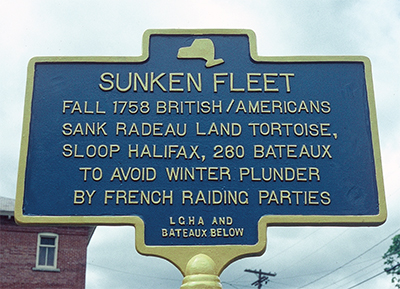
Sunken Fleet
Blue-and-yellow historic marker of the SUNKEN FLEET. In this historic event, the British forces at Lake George deliberately sank much of their fleet to protect them from French raiders by putting them in cold storage over the winter of 1758-1759. Since 1987, the underwater archaeology team Bateaux Below, Inc. has been studying this assemblage of sunken colonial warships.
Historical Background
In the autumn of 1758, British and provincial troops at Lake George in the colony of New York deliberately sank much of their squadron: a sloop, two radeaux (floating gun batteries), 260 bateaux, and other warships. This drastic step was necessary, since the British forces had no fortress at the lake to protect their fleet over the winter of 1758-1759; Fort William Henry had been destroyed the previous year. The "cold storage" sinking of the vessels in shallow water protected the watercraft from French raids over the winter months. As determined from the archaeological record, as many as 75% of the sunken boats were raised by the British and provincials in 1759 and then used in the successful Amherst campaign that year.
Those vessels not recovered, submerged remnants of "The Sunken Fleet of 1758," now offer underwater archaeologists an unparalleled opportunity to study French & Indian War (1755-1763) shipwrecks. In 1987, a not-for-profit organization, Bateaux Below, Inc., began a long-term underwater archaeological study of the shipwrecks of "The Sunken Fleet of 1758." Now over two decades later, Bateaux Below, Inc. is still conducting archival and field work on this collection of 18th century shipwrecks and other submerged cultural resources.
In 2008, a unique art/science collaborative project was conducted with the submerged cultural resources of "The Sunken Fleet of 1758" as the focal point. Biologist Sam Bowser and scientific divers with Bateaux Below, Inc. collected micro-scale single-celled organisms called testate amoebae from the lake sediment adjacent to the bateaux sunk in 1758. Because amoebae simply split in two when they reproduce, they are essentially immortal. In a sense, the amoebae inhabiting the sunken bateaux in 1758 are still alive today! Metaphorically, therefore, they serve as a portal to the past.
Previous Next


